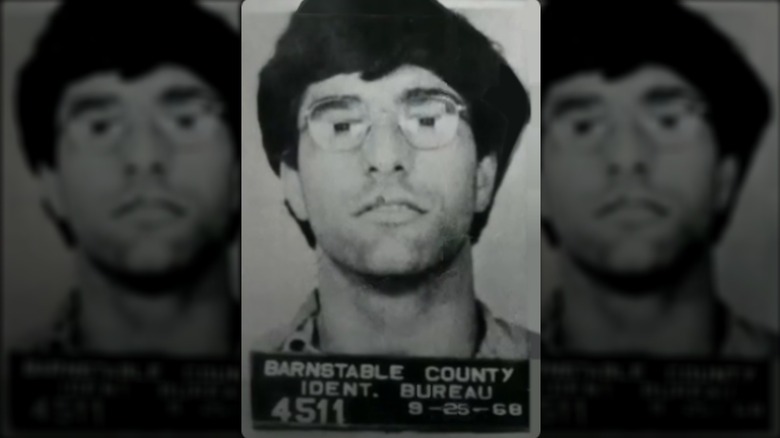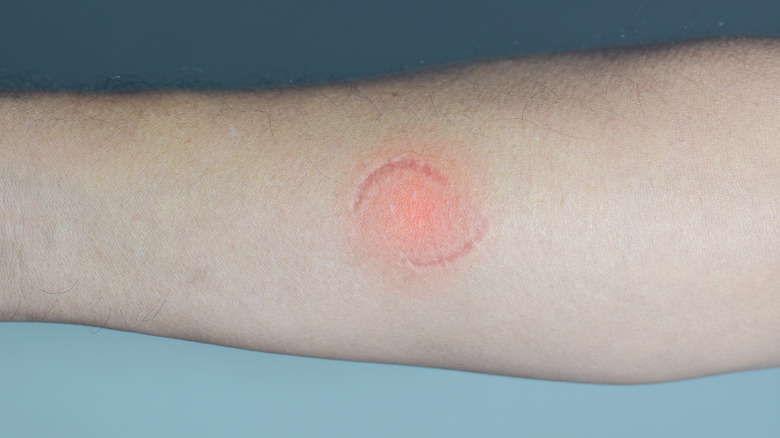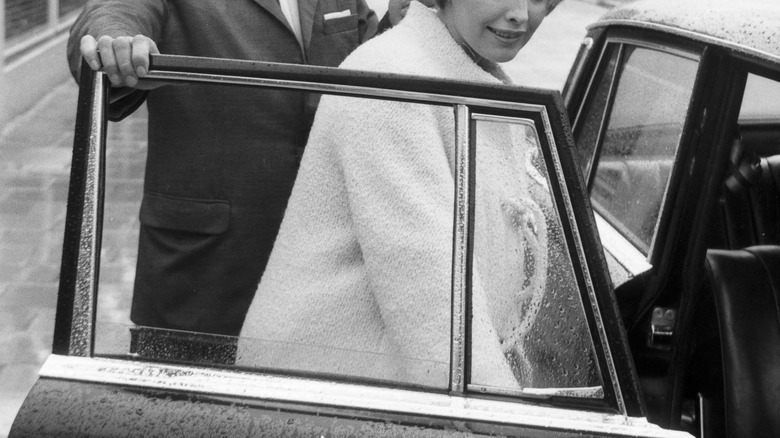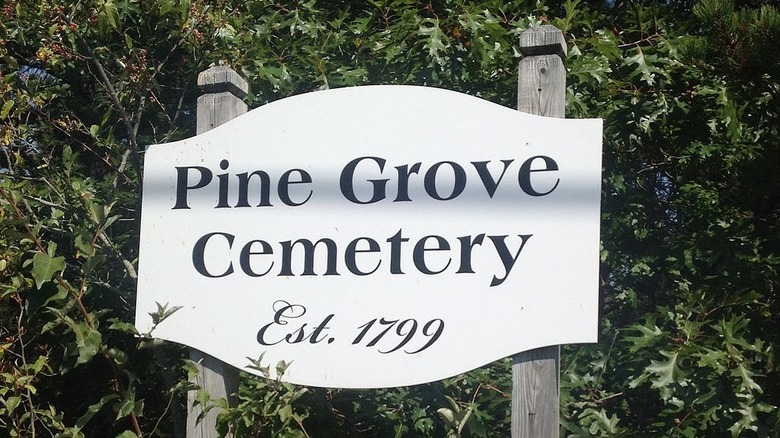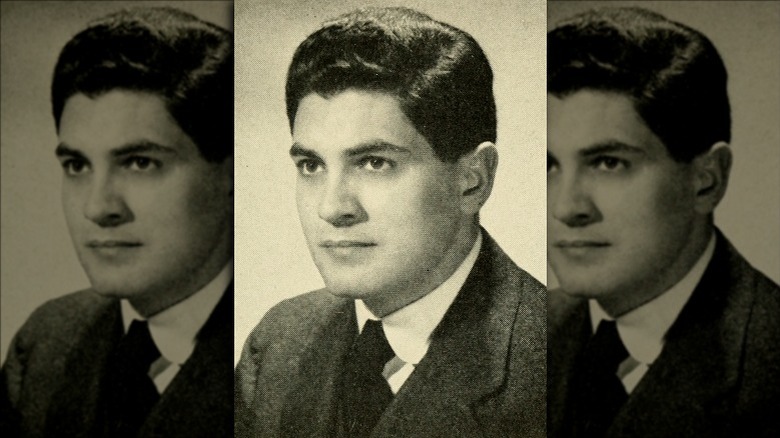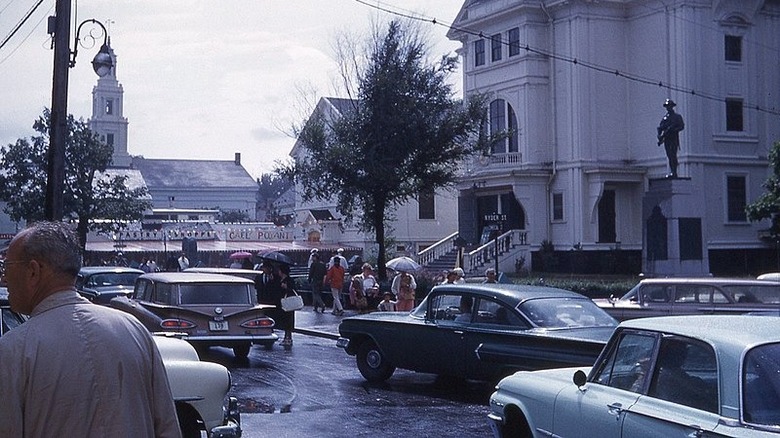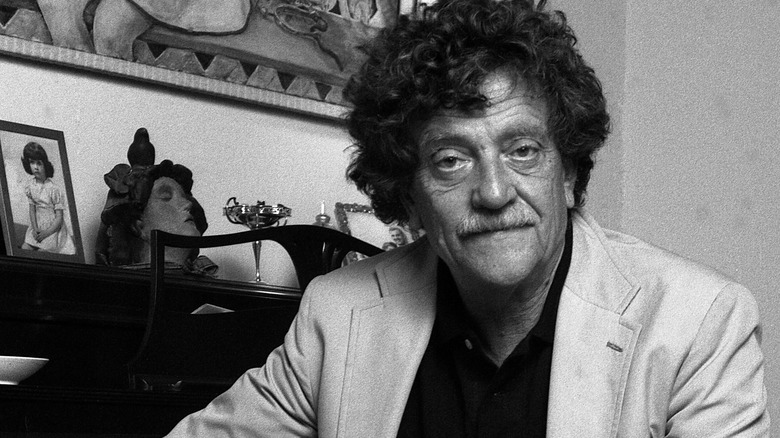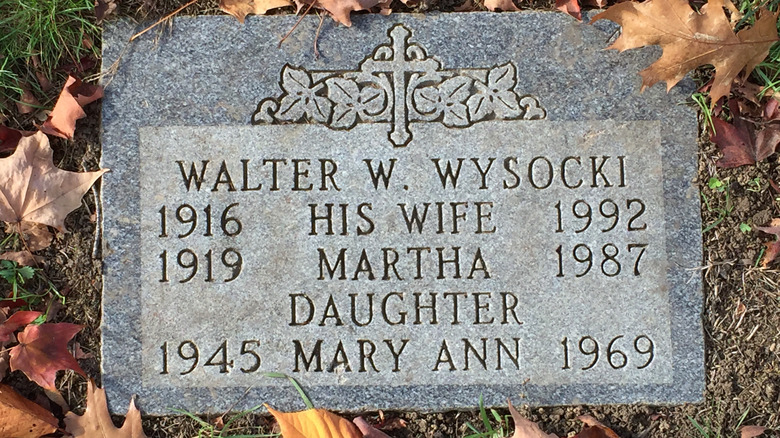The Crazy True Story Of The Cape Cod Vampire
The most surprising thing about serial killers is just how many of them there have been. This is due, in part, to its technical definition: While we might think of "serial killers" as having dozens and dozens of victims, Britannica tells us all you need is two.
The so-called "Golden Age of Serial Murder" lasted from 1970 to 1999. About 80% of all known serial killers operated during that period. Which makes Antone Charles Costa, usually known as Tony, ahead of his time: He killed at least two and probably eight women between 1966 and 1969. The circumstances of their deaths were strange, and fake news generated around his arrest made those circumstances seem even worse than they were. As a result he earned several colorful nicknames, like "Chop Chop" or "The Cape Cod Casanova." But the name that really stuck was most horrifying of all: "The Cape Cod Vampire."
Costa's life and crimes continue to fascinate. Mixing the counterculture of the 1960s, drug culture, and a handsome, charismatic young man, it's a story that lends itself to myth-making. You can't help but wonder how a man so obviously disturbed was able to operate so freely in a tight-knit community and get away with his crimes for so long. Here is the crazy true story of the Cape Cod Vampire, Tony Costa.
The Cape Cod Vampire left bite marks on his victims
Between 1966 and 1969, Tony Costa killed as many as eight women in separate incidents in different locations. But it was his final group of victims that made him famous—and earned him the nickname "The Cape Cod Vampire."
As reported by The New York Post, the Cape Cod Vampire murders involved the idyllic small towns of Provincetown and nearby Truro, Massachusetts. Normally sleepy, safe places, the discovery of several dismembered bodies in the woods near Truro was incredibly shocking. According to Boston.com, when it was explicitly stated that the bodies had teeth marks on them — implying that the murderer had bitten the victims — the media almost immediately came up with the vampire nickname, and it stuck.
The victims had been subjected to incredible brutality. Some were shot, and all had been cut into pieces, with their heads removed along with some of their organs. The bodies were then buried near a garden of sorts that Provincetown native Tony Costa maintained. According to Murderpedia, as a result of the sensationalist media coverage the garden became an instant tourist attraction. One local cop was quoted as saying "The press is bad, but the tourists are even worse."
The Cape Cod Vampire was a very convincing liar
One of the most remarkable aspects of Tony Costa's serial killer career was how he evaded suspicion for so long despite being pretty obviously linked to the victims. First, as reported by The Lineup, Costa was driving to California when he picked up two women — Bonnie Williams and Diane Federoff — and offered to take them to Pennsylvania on his way. The women never arrived at their destination. Costa was questioned about their disappearance and told police he'd taken the two women all the way to California and dropped them off. Unable to prove otherwise, the police went no further in their investigation of Costa.
In May 1968, according to The New York Post, a woman named Sydney Monzon was seen getting into Costa's car shortly before she vanished. When questioned, Costa claimed Monzon had simply run away to Europe. A few months later, a woman named Susan Perry, who was seen in Costa's company many times, also vanished. Again, when questioned, Costa told police that Perry had run away to Mexico.
Costa's stories were believable because of the rising hippie and drug culture of the late 1960s. Teenage runaways were a common occurrence, so the claims were plausible. The two women Costa supposedly drove to California were never officially found, but the bodies of both Perry and Monzon were found in 1969, brutally murdered and buried in the woods outside Truro, Massachusetts.
Costa was a brutal murderer
What set the Cape Cod Vampire apart from other serial killers was his brutality. Unlike a serial killer like the Son of Sam, Costa didn't kill from a distance with a gun. He got up close and personal, and the horror didn't end with the victim's death.
The Lineup reports that four bodies were found near Truro, Massachusetts in 1969. The first body was a woman named Susan Perry, which had been cut into eight separate pieces before burial. A month later, the police found a head and torso of Mary Anne Wysocki and the bodies of Patricia Walsh and Sydney Monzon. Walsh and Monzon had been shot in the head, but Costa had then dismembered them and cut them up badly with a knife.
According to CapeCod.com, after shooting them Costa took his victims to the Pine Grove Cemetery in Truro and used an ancient brick crypt to cut up the bodies in private. Then he would transport the remains to the unofficial garden he tended in the woods for a quick burial. According to Murderpedia, the body parts displayed bite marks and other post-mortem violations.
There was a lot of misinformation about the Cape Cod Vampire
When a community discovers a serial killer in its midst, panic and terror are pretty reasonable responses. It's usually up to the authorities to reassure citizens that the situation is under control and to ensure that accurate information is given out. When the victims of the Cape Cod Vampire were discovered it was a shocking scene. According to The Lineup, the bodies had been cut up and the pieces buried separately. As a result, there was already a bit of a media circus going on when District Attorney Edmund Dinis (pictured) addressed reporters—and made everything worse by making up most of the information he gave out.
As noted by author Sam Baltrusis, Dinis told everyone that the hearts of each woman had been removed and could not be located, that a strange "razor-like" cutting device had been found near the burial sites, teeth marks had been found on the body parts, and that the bodies had been cut into "as many parts as there are joints." Then Murderpedia reports that when a reporter seized on the bite marks and asked if the killer was "a Cape Cod Vampire," Dinis inexplicably said yes.
The only problem? Most of that was untrue or exaggerated. Whatever Dinis intended to do, what he actually did was create a media frenzy surrounding the case.
His 'garden' was a cannabis farm
Tony Costa was a product of the 1960s counterculture, so the fact that he was an enthusiastic amateur cannabis farmer isn't too surprising. But his enthusiasm for home-grown weed led to his downfall.
As reported by The Cape Cod Times, when Patricia Walsh and Mary Ann Wysocki went missing in 1969, Tony Costa was immediately a person of interest. The two women had lived in the same guest house as Costa, and as Murderpedia explains, Costa was already a suspect in the earlier disappearance of two other local women, Susan Perry and Sydney Monzon.
While searching for Walsh and Wysocki, police discovered the dismembered body of Susan Perry, which kicked the investigation into high gear. A month later, the remains of Walsh and Wysocki were found buried in the woods outside Truro. According to authors Liza Rodman and Jennifer Jordan, Costa referred to this spot as his "secret garden" and used it to grow marijuana plants. Costa also used the site to bury a stash of drugs he'd stolen from a doctor's office a few years earlier, and frequently brought women there to take drugs. Once the police learned that the "garden" had been created by Costa, they had the connection they needed. He was immediately arrested on suspicion of murder.
The Cape Cod Vampire was a prolific drug user
There's little doubt that Tony Costa, a.k.a. The Cape Cod Vampire, was dangerously mentally ill. Murderpedia reports that he was diagnosed with a "schizoid personality" shortly after his arrest. But there was another factor at work: Costa's love affair with illegal drugs.
As noted by authors Liza Rodman and Jennifer Jordan, the Cape Cod area attracted a large population of hippies and had a steady supply of drugs flowing through it. Tony Costa was an enthusiastic user, which according to The Lineup, caused his marriage to disintegrate. He even broke into a doctor's office in 1968, stealing about $5,000 worth of prescription drugs, which he buried in his "secret garden" out in the Truro woods.
The New York Post reports that Costa not only took heroic amounts of drugs, but he also sold them in town, offering a selection of uppers, downers, and hallucinogens. In fact, Costa was soon the biggest dealer in Provincetown, Massachusetts—and the only one who worked year-round. After his arrest, Costa tried to turn his drug habit into an asset by implying that his drug use was to blame for the violent murders he'd committed, and often claimed his drug use had clouded his memory so he couldn't remember any of his actions.
The Cape Cod Vampire was befriended by Kurt Vonnegut
When the story of the Cape Cod Vampire murders exploded in 1969, it dominated everyone's attention—including famed novelist Kurt Vonnegut. According to Boston.com, the author of "Slaughterhouse-Five" was living in nearby West Barnstable at the time, and wrote about the case in a famous essay published in Life magazine, "There's a Maniac Loose Out There." According to author Sam Baltrusis, Vonnegut not only clarified the details of the case for the public, but he managed to really capture the atmosphere in Provincetown and Truro, even spotting some strangely prophetic graffiti in town that read "Tony Costa Digs Girls."
Vonnegut had more than just sensational interest in the story, though. As noted by author Marc Leeds, Vonnegut's daughter Edith had spent a "crazy summer" in Provincetown and knew Costa very well—she had even turned down his invitation to see his secret garden. That crazy brush with someone now known to be a serial killer propelled Vonnegut to take a very strong interest in the case—and in Costa himself.
As reported by The Lineup, Vonnegut and Costa corresponded several times after Costa's arrest. In his letters, Costa protested his virtue and tried to convince the author that he was incapable of harming anyone. Vonnegut thought that Costa seemed to sincerely believe in his own innocence.
Costa was only convicted of two murders
Despite his brutality, sloppy approach to covering up his misdeeds, and clear connection to at least eight dead or missing women, the police and prosecutor in the Cape Cod Vampire case had some trouble pinning down Tony Costa's crimes.
Boston.com reports that Costa was suspected of killing at least four women, and possibly as many as eight. But The Lineup notes that Costa was only arraigned on three counts of murder. According to author Robin Smith-Johnson, Costa was held in jail for 14 months before finally being brought to trial, with charges involving only the two of his victims who had initially been positively identified: Mary Ann Wysocki and Patricia Walsh. Authors Liza Rodman and Jennifer Jordan explain that the prosecutors decided to only pursue charges they were certain of. A later trial was planned for the murder of his other victims at a later date.
During his trial, Costa's attorney attempted to use an insanity defense, claiming that Costa's heavy drug use was responsible for his violent behavior. Despite an earlier diagnosis as a "schizoid personality," the jury apparently believed Costa knew exactly what he was doing, and he was convicted and sentenced to life in prison for his crimes, making further trials unnecessary.
The Cape Cod Vampire wrote a novel
Long before O.J. Simpson tried to cash in on his horrific alleged crimes with "If I Did It," Tony Costa, a.k.a. The Cape Cod Vampire, tried to give his side of the story in the late 1970s by writing a "fictional" account of the ghastly murders he had committed.
As reported by Murderpedia, Costa wrote a "factual novel" while serving his life sentence in prison. The novel, titled "Resurrection," introduces us to a mysterious friend Costa calls "Carl." Costa's story is that two of his alleged victims died of drug overdoses while partying with Carl, and Carl—not Costa—shot the other two victims. According to the story, Costa was only involved in dismembering and burying the bodies, not in the actual murders. In fact, he claimed that after "Carl" shot Wysocki and Walsh, he subdued his friend and then performed a mercy killing on Wysocki, who was still alive but suffering terribly.
According to authors Liza Rodman and Jennifer Jordan, Costa's lawyer, Maurice Goldman, was horrified when his client showed him the novel and warned him not to show it to anyone—but Costa had already passed the manuscript around to several inmates and even submitted it to publisher Houghton Mifflin.
The serial killer was a beloved babysitter
Every parent knows the anxiety of leaving your children in the care of someone you don't know well. No matter how many references and safeguards you use, there's always the possibility that the person you've trusted with your kids will turn out to be dangerous.
So you can only imagine what parents in Provincetown and Truro, Massachusetts felt when Antone Costa was revealed to be the Cape Cod Vampire, a serial killer responsible for at least four brutal murders and possibly as many as eight. Although Costa's main income when living in Provincetown in the late 1960s appears to have been drug dealing, according to The Provincetown Independent, Costa worked as a handyman at the Royal Coachman Motor Lodge in the late 1960s, as well as a carpenter doing odd jobs. He also dabbled in a little babysitting.
The New York Post reports that author Liz Rodman lived in Provincetown. Her mother often hired Tony Costa to watch her daughters, and Rodman carried fond memories of her "favorite" babysitter. Costa bought the girls ice cream, gave them rides in his truck, and even gave them a tour of his "secret garden" where he grew cannabis—and eventually buried his mutilated, dismembered victims. Rodman recalls that in 1969 Costa suddenly disappeared and no one would tell her where he'd gone. It took her decades to realize that the man she'd trusted so implicitly was a crazed serial killer.
Costa abused the living as well
Like many disturbed, violent people, Tony Costa was in some ways passing on trauma he'd experienced in his own life. He never knew his father, who passed away when Tony was just a baby. Years later, Tony reported seeing his father entering his room at night. As reported by The New York Post, Costa was allegedly sexually assaulted by an older boy when he was just 12 years old. Authors Liza Rodman and Jennifer Jordan note that as is very common with assaults on children, the crime was never reported or investigated.
Costa's subsequent behavior reflects that abused past. Murderpedia reports that 1961, when Costa was 16 years old, he twice invaded the home of a teenage neighbor, attempting to drag her from her bed. The Lineup notes that Costa got married in 1963, and eventually had three children with his wife, Avis. But as his drug use increased, Tony became abusive towards Avis and his children, even sexually assaulting his wife—though she did not consider it such at the time, because they were married (and at the time husbands could not be charged with sexual assault against their wives). Avis filed for divorce in 1968 as a result of Tony's increasingly erratic behavior and abuse.
The Cape Cod Vampire may have been killed in prison
Tony Costa was convicted of murdering two young women in Provincetown, Massachusetts and sentenced to life in prison. He began serving his sentence at the Massachusetts Correctional Institution—Cedar Junction (formerly known as MCI-Walpole) in 1970. According to Murderpedia, on May 12, 1974, a corrections officer found Costa hanging from a leather belt in his cell, dead. The death was officially ruled a suicide, but as The New York Post notes many people question that conclusion and speculate that Costa was murdered by his fellow inmates. According to authors Liza Rodman and Jennifer Jordan, people who knew Costa believed he wasn't the sort of person to ever take his own life. Costa also had a habit of lecturing his fellow inmates about drug use, and there is evidence he was routinely assaulted during his time behind bars. His attorney theorized that Tony resisted the advances of other inmates and was killed as a punishment.
Another theory for why Costa's fellow criminals would go to the trouble of murdering him could be the bizarre "factual novel" he wrote detailing his version of how the crimes were committed, which may have offended the other prisoners.
